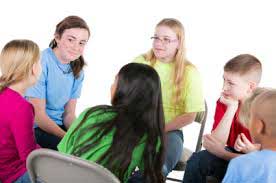What is Group Therapy?
Group therapy involves one or two therapists working with a select small group of clients. Groups are often designed to target specific problems such as anxiety, depression, or an eating disorder. Other groups focus on improving social skills, or helping clients cope with a range of challenges such as low-self esteem, emotional regulation, shyness or a recent loss.

Groups can be time limited, with a predetermined number of sessions or they can be indeterminate (also known as an ongoing group) where the therapist and or group determine when the group should end. The design, therapeutic approach and duration of the group are determined by the focus of the group and the therapist’s theoretical orientation.
In addition to providing support, groups are designed to teach and instill proven strategies for coping with specific problems.
Is group therapy for children different?
Since children have a natural ability to express themselves and resolve conflict through play, groups targeted at young children will incorporate various forms of play into the session. This may include spontaneous play or structured play activities such as role-playing, drawing, or board games.
Pre-adolescents and adolescents are better able to express their emotions verbally and developmentally interested in peer feedback and support. Groups targeting this age group will likely have a combination of talk therapy and structured activities.
What are the benefits of group therapy?
Joining a group may feel intimidating at first, but group therapy can provide many benefits that individual therapy does not.
- Universality: Children and adolescents often feel their problems are unique to them and this can lead to feelings of loneliness. Being a part of a group of people who have similar problems make children feel validated, supported, and understood.
- Sharing: Through the use of developmentally appropriate activities, children and adolescents will be able to appropriately articulate feelings and social feedback that they would have difficulty expressing to adults.
- Forming Relationships: Groups provide a safe and structured environment that allows kids to have positive social interactions with peers that create supportive bonds.
- Social skills: Groups provide a setting in which children and adolescents are able to learn through social interactions. The therapist models active listening, providing constructive feedback, and offering support. Group members also provide feedback on social behaviors. Over time group members pick up on these behaviors and implement them both in-group setting and in their everyday lives.
- Improved self-esteem: Group therapy provides a platform for children and adolescents to help others. Many times children feel as though they cannot help others because they have needed so much support themselves. However, in a group setting they realize that they have skills and experience that may be helpful to their peers. The power of helping others is therapeutic and enhances self-esteem and self-worth.
- Increased coping skills: Through the use of structured activities, the therapist teaches proven strategies to cope with specific problems. Group members will have the opportunity to practice these skills in a safe environment and receive feedback. With time group members begin incorporating these strategies into their daily lives.
Does group therapy replace individual therapy?
Group therapy is an effective form of treatment for children and adolescents. It can be done alone or in combination with individual therapy. If your child is receiving individual therapy, it is best to speak to your therapist about your child’s individual treatment plan. There are cases where children must be receiving individual therapy in addition to group therapy. Your provider can best help you determine the treatment plan.
The group therapist will conduct an intake and determine the appropriateness of the group to meet your child’s needs. Many times groups can be the gateway into individual work as children develop a sense of comfort and security in talking about their problems to an adult.
How effective is group therapy?
Research indicates that group therapy is very effective for children particularly it indicates that adolescents benefit greatly from group therapy. There are many reasons why this is the case. Children in middle school and early high school have attained a god cognitive grasp of what emotions are, and can distinguish subtle differences in feelings. However, they are also acquiring the ability to think abstractly and think about their own thought processes and this often leads to conflicting feelings. As a result feelings can be quite overwhelming for adolescents.
Through group therapy, adolescents can communicate in a way that normalizes these feelings and experiences. They are able to learn about themselves, the impact their behavior has on others, and are able to receive feedback from peers. At this age it is developmentally appropriate for adolescents to prefer feedback from peers than adults, which is another reason adolescents are oftentimes more open to this treatment modality.
Group therapy is also effective for young children. Children this age have a limited understanding of emotions and can often be very labile and reactive. Guided interactions with peers can increase emotional intelligence and develop social skills that are critical developmental goals for this age group.
If your child is struggling with anxiety, depression, socialization, or has recently experienced loss or change; he/she may benefit greatly from group therapy. This type of treatment is very effective in treating various problems and providing coping skills while also creating an environment that fosters peer relationships.
-Topic written by Karol Espejo, LGSW